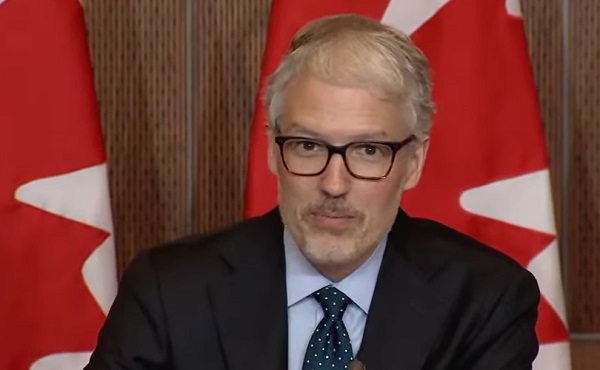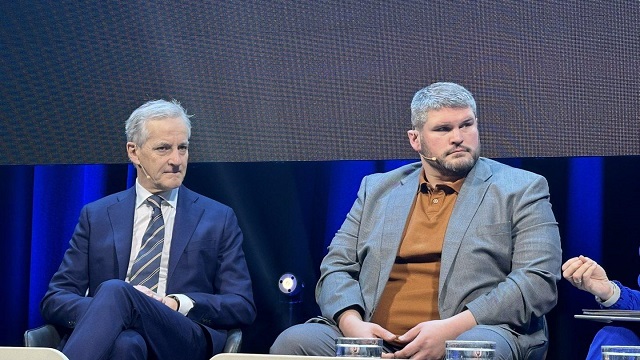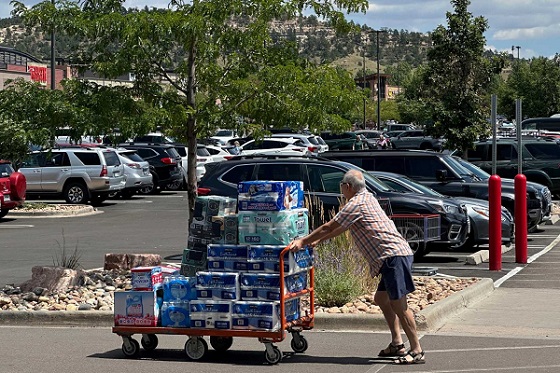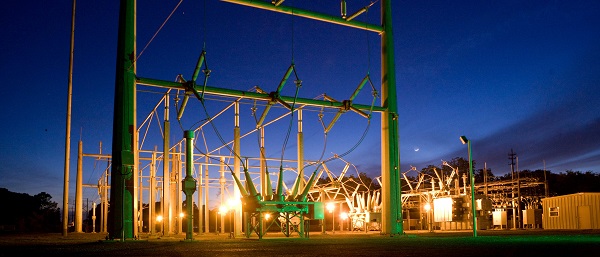Alberta
Alberta’s close brush with blackouts stiffens Moe’s resolve

From the Frontier Centre for Public Policy
“We will not risk plunging our homes, schools, hospitals, special care homes and our businesses into the cold and darkness because of the ideological whims of others.”
Alberta’s close brush with possible rolling blackouts stiffens Moe’s resolve to keep the lights on.
Moe reiterates: “We will not attempt the impossible when it comes to power production”
The past weekend proved to be a close-run thing for the Alberta electrical grid, and Saskatchewan Premier Scott Moe is making statements resolving he won’t allow that to happen here.
Specifically, after having nearly completely divested itself of coal-fired power production, Alberta’s dramatic buildout of wind and solar proved impossible to keep the lights on in that province when the chips were down and temperatures hit -35 C, or worse.
“In Saskatchewan, we will not attempt the impossible when it comes to power production in our province,” Moe said in a post on X and other social media the evening of Monday, Jan. 15.
“We will not risk plunging our homes, schools, hospitals, special care homes and our businesses into the cold and darkness because of the ideological whims of others.
“To support the ongoing power demands across western Canada, Boundary Dam 4 has been restarted to ensure families can continue to keep the heat on. Net zero by 2035 is not only impossible, it’s irresponsible as it would leave Saskatchewan and Western Canadian families freezing and in the dark.”
It was in response to the extraordinary events that occurred in Alberta over the weekend, in which Saskatchewan played a key part. And it was also a tacit acknowledgement that as much as SaskPower’s been trying to wean itself off coal, it just can’t do it yet. We still need it to keep the lights on.
The Alberta Electric System Operator (AESO) declared four “grid alerts,” over four days in a row, starting the afternoon of Friday, Jan. 12. Desperately cold temperatures drove up demand for power, just as the same temperatures reduced wind power generation to nothing at times, and close to nothing for most of the weekend. And since the mass of cold air stretched from the Yukon to Texas, every grid operator in between was in the same boat – high demand but short supply. The Southwest Power Pool, which incorporates parts of 14 states from south of Saskatchewan to the Texas Panhandle, as well as Texas grid operator ERCOT, all put out various forms of alerts suggesting their clients reduce electrical consumption.
Staring into the abyss
The first three of Alberta’s grid alerts ran from mid-afternoon until late evening, but the fourth occurred for an hour on Monday morning, as the workweek began.
The second of those grid alerts turned out to be the most significant. On Saturday, Jan. 13, Alberta came within a half-hour of rotating blackouts, an Alberta Electric System Operator spokesperson told CBC News on Jan. 15, confirmed by Alberta Affordability and Utilities Minister Nathan Neudorf the same day.
Indeed, the province stood at the brink of the abyss Saturday night, as rotating blackouts would have impacted different areas of the province for 20 to 30 minutes at a time, as temperatures ranged from -30 to -45 C, depending on where you were in the province. As the province’s grid-scale batteries neared depletion, and there was nothing left to call upon, the AESO and provincial government put out an emergency alert to all cellphones and TV screens, asking Albertans to shut off and unplug everything they could, from electric vehicle chargers to ovens to bathroom fans.
SaskPower ups its game
Alberta had run out of reserves, and with British Columbia unable to provide much more in the way of additional power, and Montana unable provide much at all, Saskatchewan’s Crown utility SaskPower responded, by sending 153 megawatts westward.
And that, in itself, was extraordinary, because limits were pushed to provide Alberta with as much as possible on the intertie between the two provinces.
SaskPower spokesperson Joel Cherry told Pipeline Online by email, “One hundred fifty-three megawatts is the interconnection’s maximum capacity, but it has been derated to 90 megawatts for the past several months because of ongoing work at a interconnection station at the border. AESO and SaskPower Grid Control have agreed to temporarily increase the transmission capacity to make the extra 63 MW available to Alberta when they declare energy alerts.
Contingency reserve had run out
Generally speaking, power needs to be consumed at the instant its produced. There is very little in the way of grid-scale storage in the Canadian electrical grid, although Alberta has built 10 grid-scale batteries totaling 190 megawatts capacity. All of that capacity would come into play Saturday evening.
Grid operators must maintain a small amount of excess capacity at all times, known as a “dispatched contingency reserve” (DCR) The North American Electric Reliability Corporation (NERC) standard is to maintain at least 4 per cent DCR. That’s because if the DCR runs out, all sorts of bad things happen, with voltage drops and frequency variance which then can lead to cascading brownouts, including additional power generating units tripping off and whole areas going without power.
With demand hovering around 11,800 megawatts, four per cent would have been around 472 megawatts DRC. Instead, for the better part of an hour, the DCR was 20 megawatts, or 0.1 per cent, a razor thin margin. The extra 63 megawatts SaskPower sent in part meant the difference between rotating blackouts or not.
In a very real way, it was payback for Alberta’s weeks-long help for SaskPower during the outage of the Poplar River Power Station at Coronach, Saskatchewan. For weeks on end, Alberta supplied Saskatchewan with around 150 megawatts for parts of the day to keep the lights on in this province.
BC played critical role, too
On any given day, imports and exports of power between Alberta and British Columbia will often run up to 600 megawatts going either direction. But with BC also in the deep freeze, it didn’t have much to give at various points during the weekend, including parts of the crucial Saturday evening. Indeed, around the time the grid alert was first sounded on Saturday, Alberta was still exporting 38 megawatts to British Columbia, according to X bot account @ReliableAB, which posts hourly data from the AESO on the status of the Alberta grid.
For a few hours, BC Hydro was able to ramp up its exports to Alberta during the crucial time. At 5:39, they were exporting 251 megawatts to Alberta, nearly 100 megawatts more than Saskatchewan. For the next few hours they sent around 200 megawatts, but it was not enough, and the AESO sent out its alert.
Additionally, during the third grid alert on Sunday, British Columbia ramping up its power exports at a critical time saved the day, as the Alberta Dispatched Contingency Reserve had briefly hit zero. BC bumped its exports up to 496 megawatts while Saskatchewan contributed 153 and Montana nine. Those increased megawatts from British Columbia appeared to make all the difference on that day.
The cat came back, and so did Unit 4
While all of this was going on, SaskPower spent the weekend getting its coal fired power station Boundary Dam Unit 4 back into play. It’s been on cold standby for months. Officially, by federal regulations it was supposed to retire Dec. 31, 2021, but SaskPower has been forced to bring it back into service multiple times to fill a need, such as when Poplar River went offline last June. It was 139 megawatts that could have been used, but SaskPower has shown reluctance to bring it back into the game, as it were.
And that’s what Moe alluded to in his social media post, saying, “We will not risk plunging our homes, schools, hospitals, special care homes and our businesses into the cold and darkness because of the ideological whims of others.”
This was an oblique reference to the push by the federal government to shut down coal and natural gas-fired power generation by 2035, according to the proposed Clean Electricity Regulations, using similar words that Moe has expressed before. The federal preference is for more renewables, in particular wind and solar.
Several years ago, the federal government and Saskatchewan reached an equivalency agreement, recognizing the Boundary Dam Unit 3 Carbon Capture and Storage Project and therefore allowing a few more years operation out of other coal units. But to get that agreement, SaskPower had to agree to adding a further 3,000 megawatts of wind and solar by 2035, according to SaskPower president and CEO Rupen Pandya in an interview Sept. 25, 2023.
Pandya said, “When we signed the equivalency agreement with the federal government in 2014 to allow us to keep using coal to the end of 2030, part of that agreement required us to build out renewables in the province, so that we could operate coal assets, coal generators, past their end of life. And that’s what we’ve been able to do. And we continue to do. So, part of the build out of renewables that’s required as part of the equivalency agreement, that 3,000 megawatts that we need to put in place by 2035. I think 2,000 by 2030. A good tranche of that will be in that south central part of Saskatchewan around the Coronach. So we currently have in the market an RFP for 700 megawatts of wind and solar in the Coronach region, so it’ll will actually go into power, if all goes well with RFPs, in 2027.”
On a typical fall day, SaskPower’s total power demand hovers around 3,000 megawatts. On a cold winter day, it’s closer to 3,500 megawatts. But that’s before widespread adoption of electric vehicles, which the federal government is also trying to force upon Canadians.
Saskatchewan held up to the cold
SaskPower’s Joel Cherry told Pipeline Online on Jan. 15, “Saskatchewan’s system has held up during the extreme cold. We had no major issues.”
However, “Poplar River Power Station was operating at reduced capacity earlier in the weekend because of issues with coal supply. As of yesterday (Sunday) we are back to normal operations there.”
That means the reduced capacity occurred the same day Alberta was stretched nearly to the breaking point.
Asked if we lost a major unit, while Alberta was at the same time in crisis, what did we have for backup? Was there additional capacity available from Manitoba and/or Southwest Power Pool?” Cherry replied, “SaskPower has maintained adequate reserves to allow for the continued stability of the system even if we lost a large unit. We have also been importing from Manitoba and the SPP when available.
Collapse of wind
Major factors in Alberta’s power woes were the utter collapse of wind and solar power generation. Even at its best, solar power production during the day was around a third of maximum capacity.
Wind turbines started shutting down Thursday night as temperatures plummeted below -30 C, the temperature where cold brittle behaviour of materials risks catastrophic failure of the turbines. The three evening grid alerts all came on as the sun went down and the roughly 500 megawatts (of 1,650 megawatts capacity) faded with the setting sun. On Friday, Alberta’s wind generation fell to 6 megawatts at one point. It was minimal on Saturday. On Sunday morning, multiple times wind hit zero – not one megawatt from the 4,481 megawatts of wind generation capacity.
SaskPower’s Where Your Power Comes From webpage noted on Friday, Jan. 14, Saskatchewan’s 617 megawatts of grid-scale wind produced a 24-hour average of 21 megawatts. On Saturday, that number was 19. On Sunday, the average was 22 megawatts. Unlike the previous week, where there were seven days where wind in Saskatchewan hit zero power output, Jan. 12-14 did not have any periods of zero.
“We had four hours of less than 10 megawatts wind output on Jan 12, despite the low average through the day on Jan. 13 we only had a half hour below 10 megawatts and on Jan 14 we had 7.8 hours below 10 megawatts,” Cherry said.
Ten megawatts is 1.6 per cent of total grid-scale wind capacity in Saskatchewan.
As for Unit 4, in April of 2023, Pipeline Online reported Cherry said at the time, “We’re going to keep BD 4 in laid up status until Great Plains Power Station comes online, or until March 31, 2024.”
The most recent plan, as of April, 2023, was to shut down, for good, Unit 4 by March 31, 2023. Whether Moe’s statement on Jan. 15 will extend that is unknown at the time of writing.
Brian Zinchuk is editor and owner of Pipeline Online, and occasional contributor to the Frontier Centre for Public Policy. He can be reached at [email protected]. For further information read the original publication here.
Alberta
Click here to help choose Alberta’s new licence plate design

Your province, your plate
For the first time in more than 40 years, Alberta is refreshing its licence plate with a Strong and Free motto, and the final look will be decided by Albertans.
From Oct. 15 until Nov. 5, Albertans can take part in a tournament-style online vote for a new provincial licence plate design that proudly reflects who we are every time we hit the road.
The new licence plate will be available in late 2026 and will be based on a “Strong and Free” theme, echoing the Latin motto of our province and reflecting Alberta’s bold identity, economic strength and deep-rooted provincial pride. The motto’s inclusion on the licence plates will also serve as a nod to Canada’s national anthem and Alberta’s position as a strong and sovereign province within a united Canada.
“From our wide-open landscapes to our entrepreneurial spirit, Alberta has so much to be proud of, and our new licence plate will reflect that pride. For the first time in four decades, Albertans will choose how we tell that story. I look forward to seeing which design is selected to show the world that this is the land of the strong and free.”
With options that include famous Alberta landmarks such as the Three Sisters Mountains, and long-standing symbols of our province’s core industries including agriculture and energy production, the potential plates each contain symbols of Alberta’s beauty, history and spirit.
In the first phase of voting, Albertans can vote for their favourite of eight unique concepts that incorporate Alberta’s unique landscape and history. Following the first phase, four designs will advance to the next round of voting where the top two will be selected, and subsequently, there will be a final vote for the winning plate concept. The winning new licence plate will be announced during the fall session of the legislature.
“Alberta is strong and free, and Albertans will have the opportunity to choose a new licence plate that captures that spirit. The new licence plate will be a fresh design that every Albertan will be proud to show off, whether they’re driving to work, heading to the lake or exploring North America.”
If an Albertan wants to replace their current plate for the new licence plate once it is released, they can voluntarily pay a $28 fee. Alternatively, Albertans could obtain a new plate on their vehicle registration renewal date at no additional cost. Motorists may also continue using the previous licence plate once the new licence plate is brought onboard, provided it is still in good condition.
Quick facts
- Alberta’s current licence plate was designed in 1984.
- In 2021, Alberta began a transition from painted to reflective plates with the same design.
- The new designs each incorporate reflective technology to improve readability for law enforcement and automated systems in low-light conditions, and also meet international standards for visibility, legibility and counterfeit resistance.
Related information
Licence plate designs. Click link above to vote
Alberta
Enbridge CEO says ‘there’s a good reason’ for Alberta to champion new oil pipeline

Enbridge CEO Greg Ebel. The company’s extensive pipeline network transports about 30 per cent of the oil produced in North America and nearly 20 per cent of the natural gas consumed in the United States. Photo courtesy Enbridge
From the Canadian Energy Centre
B.C. tanker ban an example of federal rules that have to change
The CEO of North America’s largest pipeline operator says Alberta’s move to champion a new oil pipeline to B.C.’s north coast makes sense.
“There’s a good reason the Alberta government has become proponent of a pipeline to the north coast of B.C.,” Enbridge CEO Greg Ebel told the Empire Club of Canada in Toronto the day after Alberta’s announcement.
“The previous [federal] government’s tanker ban effectively makes that export pipeline illegal. No company would build a pipeline to nowhere.”
It’s a big lost opportunity. With short shipping times to Asia, where oil demand is growing, ports on B.C.’s north coast offer a strong business case for Canadian exports. But only if tankers are allowed.
A new pipeline could generate economic benefits across Canada and, under Alberta’s plan, drive economic reconciliation with Indigenous communities.
Ebel said the tanker ban is an example of how policies have to change to allow Canada to maximize its economic potential.
Repealing the legislation is at the top of the list of needed changes Ebel and 94 other energy CEOs sent in a letter to Prime Minister Mark Carney in mid-September.
The federal government’s commitment to the tanker ban under former Prime Minister Justin Trudeau was a key factor in the cancellation of Enbridge’s Northern Gateway pipeline.
That project was originally targeted to go into service around 2016, with capacity to ship 525,000 barrels per day of Canadian oil to Asia.
“We have tried to build nation-building pipelines, and we have the scars to prove it. Five hundred million scars, to be quite honest,” Ebel said, referencing investment the company and its shareholders made advancing the project.
“Those are pensioners and retail investors and employees that took on that risk, and it was difficult,” he said.
For an industry proponent to step up to lead a new Canadian oil export pipeline, it would likely require “overwhelming government support and regulatory overhaul,” BMO Capital Markets said earlier this year.
Energy companies want to build in Canada, Ebel said.
“The energy sector is ready to invest, ready to partner, partner with Indigenous nations and deliver for the country,” he said.
“None of us is calling for weaker environmental oversight. Instead, we are urging government to adopt smarter, clearer, faster processes so that we can attract investment, take risks and build for tomorrow.”
This is the time for Canadians “to remind ourselves we should be the best at this,” Ebel said.
“We should lead the way and show the world how it’s done: wisely, responsibly, efficiently and effectively.”
With input from a technical advisory group that includes pipeline leaders and Indigenous relations experts, Alberta will undertake pre-feasibility work to identify the pipeline’s potential route and size, estimate costs, and begin early Indigenous engagement and partnership efforts.
The province aims to submit an application to the Federal Major Projects Office by spring 2026.
-

 Censorship Industrial Complex22 hours ago
Censorship Industrial Complex22 hours agoCanada’s privacy commissioner says he was not consulted on bill to ban dissidents from internet
-

 Alberta21 hours ago
Alberta21 hours agoEnbridge CEO says ‘there’s a good reason’ for Alberta to champion new oil pipeline
-

 Business21 hours ago
Business21 hours agoFormer Trump Advisor Says US Must Stop UN ‘Net Zero’ Climate Tax On American Ships
-

 Energy1 day ago
Energy1 day agoIndigenous Communities Support Pipelines, Why No One Talks About That
-

 Business1 day ago
Business1 day agoFinance Committee Recommendation To Revoke Charitable Status For Religion Short Sighted And Destructive
-

 Alberta1 day ago
Alberta1 day agoOil Sands are the Costco of world energy – dependable and you know exactly where to find it
-

 Business2 days ago
Business2 days agoFinance Titans May Have Found Trojan Horse For ‘Climate Mandates’
-

 Health1 day ago
Health1 day agoColorado gave over 500 people assisted suicide drugs solely for eating disorders in 2024






